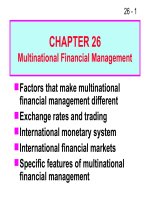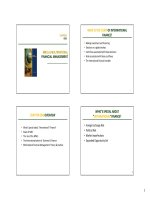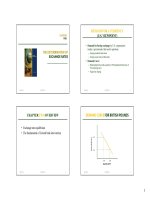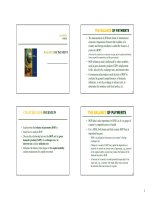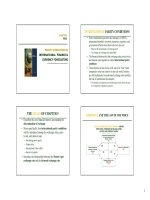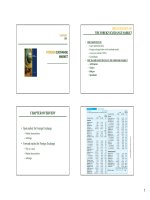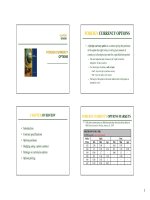Multinational financial management 7th CH07
Bạn đang xem bản rút gọn của tài liệu. Xem và tải ngay bản đầy đủ của tài liệu tại đây (938.56 KB, 36 trang )
Multinational Financial
Management
Alan Shapiro
7th Edition
Power Points by
J.Wiley & Sons
Joseph F. Greco, Ph.D.
California State University, Fullerton
1
CHAPTER 7
THE FOREIGN
EXCHANGE
MARKET
2
CHAPTER OVERVIEW
I.
INTRODUCTION
II.ORGANIZATION OF THE
FOREIGN EXCHANGE
MARKET
III. THE SPOT MARKET
IV. THE FORWARD MARKET
3
PART I. INTRODUCTION
I.
INTRODUCTION
A.
The Currency Market:
where money denominated
in one currency is bought
and sold with money
denominated in another
currency.
4
INTRODUCTION
B.
International Trade and Capital
Transactions:
facilitated with the ability
to transfer purchasing power
between countries
5
INTRODUCTION
C.
Location
1.
OTC-type: no specific
location
2.
Most trades by phone,
telex, or SWIFT
SWIFT: Society for Worldwide Interbank
Financial
Telecommunications
6
PART II.
ORGANIZATION OF THE FOREIGN
EXCHANGE MARKET
I . PARTICIPANTS IN THE FOREIGN
EXCHANGE MARKET
A. Participants at 2 Levels
1. Wholesale Level (95%)
- major banks
2. Retail Level
- business customers
7
ORGANIZATION OF THE FOREIGN
EXCHANGE MARKET
B.
Two Types of Currency Markets
1. Spot Market:
- immediate transaction
- recorded by 2nd business day
8
ORGANIZATION OF THE FOREIGN
EXCHANGE MARKET
2. Forward Market:
- transactions take place at a
specified future date
9
ORGANIZATION OF THE FOREIGN
EXCHANGE MARKET
C. Participants by Market
1.
Spot Market
a. commercial banks
b. brokers
c. customers of commercial
and central banks
10
ORGANIZATION OF THE FOREIGN
EXCHANGE MARKET
2. Forward Market
a. arbitrageurs
b. traders
c. hedgers
d. speculators
11
ORGANIZATION OF THE FOREIGN
EXCHANGE MARKET
II. CLEARING SYSTEMS
A. Clearing House Interbank
Payments System
(CHIPS)
- used in U.S. for electronic
fund transfers.
12
ORGANIZATION OF THE FOREIGN
EXCHANGE MARKET
B. FedWire
- operated by the Fed
- used for domestic
transfers
13
ORGANIZATION OF THE FOREIGN
EXCHANGE MARKET
III. ELECTRONIC TRADING
A. Automated Trading
- genuine screen-based
market
14
ORGANIZATION OF THE FOREIGN
EXCHANGE MARKET
B. Results:
1.
Reduces cost of trading
2.
Threatens traders’
oligopoly of information
3.
Provides liquidity
15
ORGANIZATION OF THE FOREIGN
EXCHANGE MARKET
IV.
SIZE OF THE MARKET
A. Largest in the world
1999:
US$1.5 trillion daily
or
US$375 trillion a year
In 1999 the US GDP was US$9.1 trillion
16
ORGANIZATION OF THE FOREIGN
EXCHANGE MARKET
B. Market Centers (1998):
#1: London = $637 billion
daily
#2: New York= $351 billion
daily
#3: Tokyo = $149 billion
daily
17
PART III.
THE
SPOT
MARKET
I.
SPOT
QUOTATIONS
A. Sources
1.
All major newspapers
2.
Major currencies have
four different quotes:
a.
spot price
b.
30-day
c.
90-day
d.
180-day
18
THE SPOT MARKET
B. Method of Quotation
1. For interbank dollar
trades:
a. American terms
example: $.5838/dm
b.
European terms
example: Peso1.713/$
19
THE SPOT MARKET
2. For nonbank customers:
Direct quote
gives the home currency
price of one unit of foreign
currency.
EXAMPLE:
dm0.25/FF
20
THE SPOT MARKET
C. Transactions Costs
1.
Bid-Ask Spread
used to calculate the fee
charged by the bank
•
Bid = the price at which the
bank is willing to buy
•
Ask = the price it will sell the
currency
21
THE SPOT MARKET
4. Percent Spread Formula
(PS):
Ask − Bid
PS =
x100
Ask
22
THE SPOT MARKET
D. Cross Rates
1.
The exchange rate
between 2 non - US$
currencies.
23
THE SPOT MARKET
2. Calculating Cross Rates
When you want to know what
the dm/ff cross rate is, and you
know dm2/US$ and ff.55/US$
then dm/ff = dm2/US$ ÷
ff.55/US$
= dm3.636/ ff
24
THE SPOT MARKET
E. Currency Arbitrage
1. If cross rates differ from
one financial center to
another, and profit
opportunities exist.
25
